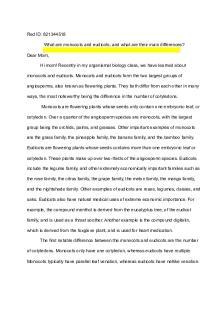Writing assignment 2 PDF

| Title | Writing assignment 2 |
|---|---|
| Author | Emily Tafoya |
| Course | Principles of Organismal Biology |
| Institution | San Diego State University |
| Pages | 2 |
| File Size | 47.3 KB |
| File Type | |
| Total Downloads | 87 |
| Total Views | 148 |
Summary
writing assignment for class ...
Description
Red ID: 821344518 What are monocots and eudicots, and what are their main differences? Dear Mom, Hi mom! Recently in my organismal biology class, we have learned about monocots and eudicots. Monocots and eudicots form the two largest groups of angiosperms, also known as flowering plants. They both differ from each other in many ways, the most noteworthy being the difference in the number of cotyledons. Monocots are flowering plants whose seeds only contain one embryonic leaf, or cotyledon. Over a quarter of the angiosperm species are monocots, with the largest group being the orchids, palms, and grasses. Other important examples of monocots are the grass family, the pineapple family, the banana family, and the bamboo family. Eudicots are flowering plants whose seeds contains more than one embryonic leaf or cotyledon. These plants make up over two-thirds of the angiosperm species. Eudicots include the legume family, and other extremely economically important families such as the rose family, the citrus family, the grape family, the melon family, the mango family, and the nightshade family. Other examples of eudicots are roses, legumes, daisies, and oaks. Eudicots also have natural medical uses of extreme economic importance. For example, the compound menthol is derived from the eucalyptus tree, of the eudicot family, and is used as a throat soother. Another example is the compound digitalin, which is derived from the foxglove plant, and is used for heart medication. The first notable difference between the monocots and eudicots are the number of cotyledons. Monocots only have one cotyledon, whereas eudicots have multiple. Monocots typically have parallel leaf venation, whereas eudicots have netlike venation.
The stems of the monocots and eudicots differ as those of the monocots have vascular tissue scattered in bundles throughout, and the eudicots have vascular tissue bundles arranged in a ring. The root system of the monocot is typically fibrous, without a main root, and the eudicot root system usually is a taproot system, with a single main root with other fibrous roots attached. The pollen grain of a monocot has only one opening whereas the eudicot has a pollen grain with three openings. The floral organs of the monocots are usually in multiples of three, and the eudicot floral organs are in multiples of four or five. These differences make it easy to determine which type of angiosperm a flower is when walking around in nature. In our own life, we are totally surrounded by angiosperms, especially monocots and eudicots. I know your favorite fruits are bananas and pineapples, and I am sure you didn’t know they were monocots! Since one of your favorite meals to cook, and mine to eat, is pineapple chicken, think of how they are monocots and what different ways you can identify that from the examples I said above. Now that you know all this information, I hope you look at plants differently and think of how economically important monocots and eudicots are. This information is useful to not just us, but to so many other people in the world. Eudicots are used every day in different medicines that are extremely beneficial to society. From the simple periwinkle plant, the compound Vinblastine is created, which is used to treat Leukemia! For those suffering from ovarian cancer, Taxol is extracted from the pacific yew plant. All this to say, eudicots and monocots are so beyond important for society. I hope when you see any of these plants, you remember how economically important they are and how they make everyone’s lives a little bit better....
Similar Free PDFs

CS331 writing assignment 2
- 6 Pages

Writing Assignment english 2
- 2 Pages

2-5 Writing Assignment
- 2 Pages

Writing assignment 2
- 2 Pages

Module 2 Writing Assignment
- 3 Pages

Writing assignment unit 2
- 5 Pages

2-2 Assignment Writing Notes
- 3 Pages

3-2 Assignment Writing Plan
- 2 Pages

PSYC 305 Writing Assignment 2
- 3 Pages

Writing assignment 2 - Grade: A+
- 2 Pages

Writing Assignment 2 - Grade: A+
- 2 Pages
Popular Institutions
- Tinajero National High School - Annex
- Politeknik Caltex Riau
- Yokohama City University
- SGT University
- University of Al-Qadisiyah
- Divine Word College of Vigan
- Techniek College Rotterdam
- Universidade de Santiago
- Universiti Teknologi MARA Cawangan Johor Kampus Pasir Gudang
- Poltekkes Kemenkes Yogyakarta
- Baguio City National High School
- Colegio san marcos
- preparatoria uno
- Centro de Bachillerato Tecnológico Industrial y de Servicios No. 107
- Dalian Maritime University
- Quang Trung Secondary School
- Colegio Tecnológico en Informática
- Corporación Regional de Educación Superior
- Grupo CEDVA
- Dar Al Uloom University
- Centro de Estudios Preuniversitarios de la Universidad Nacional de Ingeniería
- 上智大学
- Aakash International School, Nuna Majara
- San Felipe Neri Catholic School
- Kang Chiao International School - New Taipei City
- Misamis Occidental National High School
- Institución Educativa Escuela Normal Juan Ladrilleros
- Kolehiyo ng Pantukan
- Batanes State College
- Instituto Continental
- Sekolah Menengah Kejuruan Kesehatan Kaltara (Tarakan)
- Colegio de La Inmaculada Concepcion - Cebu




